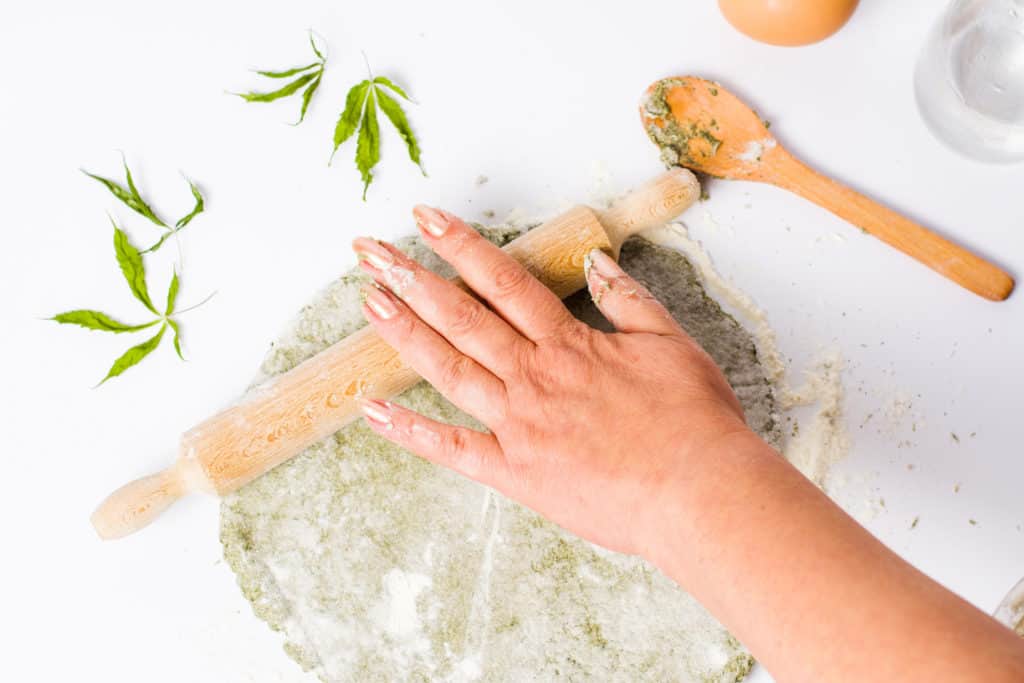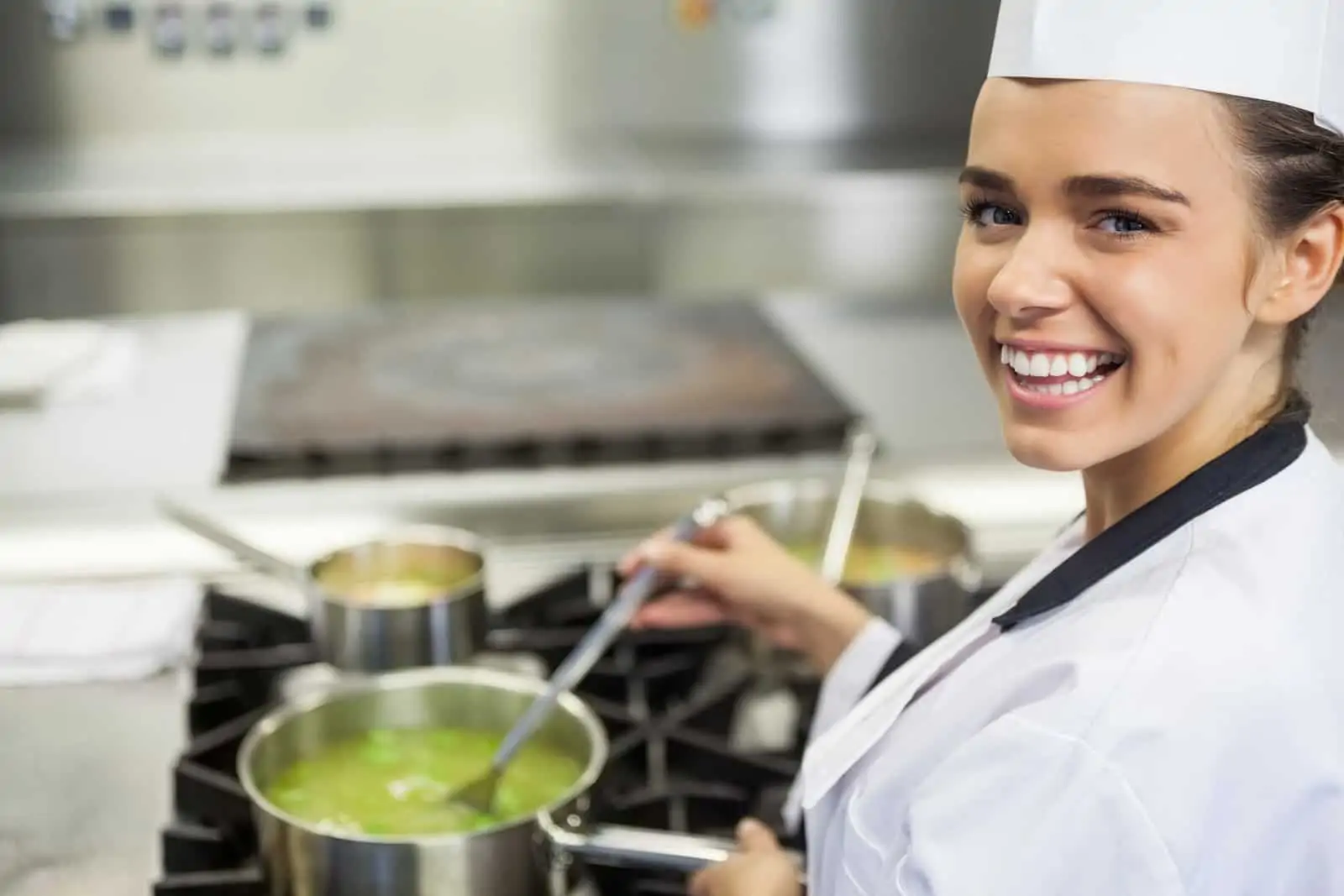TABLE OF CONTENTS
Among the wide range of jobs available in the rapidly growing cannabis industry, working as a cannabis chef, pastry chef (patissier), or chocolate maker (chocolatier) are some of the most attractive options for many people. The culinary arts field is expanding steadily, so it is only natural that cannabis cooking is now finding its niche.
To get started with cannabis cooking, most people will desire input and advice from others who are masters of the craft. There are a growing number of cannabis cooking classes in various cities.
Often classes are offered by cannabis dispensaries or established restaurant chefs who have an interest in cannabis. Another option is getting training from a reputable education provider like Cannabis Training University, which will give you the knowledge of extraction techniques, decarboxylation, dosage, cannabis strains, storage, and more to help you succeed.
Employment with a Cannabis Kitchen
Finding a job as a cannabis chef usually occurs in one of two common ways. The first is gaining employment with an established infused edibles company or a cannabis company that makes its own infused edible products.
Usually, this is an entry-level position (kitchen assistant/technician) where you learn based on company protocol, using specific recipes. In this role, you will shadow tenured employees to learn the ropes.
A kitchen assistant can start off as a part-time position in a high-volume and fast-paced kitchen environment. Kitchen assistants are responsible for measuring and preparing ingredients, checking inventory levels, preparing the product, and cleaning and organizing the work area. Kitchen assistants can make about $15 per hour.
Kitchen assistant requirements:
- Must be at least 21 years old
- Must pass a background check
- Must be eligible to obtain a cannabis worker’s permit (if applicable)
- High school diploma or equivalent degree (preferred)
- Must obtain a food handler’s card
- Prior culinary and cooking experience is a plus
- Must be able to lift up to 50 pounds
- Must be able to stand for a full shift
Most commercially available infused edibles sold in retail stores are sweets, usually baked goods, chocolates, or candy. While some stores carry products created by leading edibles brands in their state, others make their own. Whether you work on the wholesale or retail side of this market, the work is essentially the same.
Most cannabis kitchens have assigned positions for creating their confections, meaning that some staff members work with baked goods while others work as chocolatiers or others as candy makers.
Savory cannabis cuisine definitely takes a backseat in the world of cannabis retail products. Still there is an increasing market for these foods, so they will most likely become more common in the future. Cannabis-infused savory treats on the market include pizza sauce, salsa, beef jerky, peanut butter, BBQ sauce, popcorn, olive oil, and much more.
Part of the reason that savory edibles aren’t more prominent on the market is the difficulty of creating a homogeneously dosed product. Certain savory treats such as seasoned nuts would require an infused seasoning that can fall to the bottom of the packaging and create an inconsistently dosed product.
Becoming a Cannabis Chef

The route to becoming a cannabis chef who creates his or her savory dishes for special dinner guests and cooking class participants is a longer process with a less direct path than working at an edibles company.
Most cannabis chefs apprenticed in well-known restaurant kitchens and often attended and graduated from a national culinary institution. The cannabis part of their occupation came later after they mastered the skills of traditional mainstream cooking.
Choosing the right culinary school (on top of cannabis industry training) can provide you with the knowledge you need to become a chef in the food industry. In a culinary arts program, you will study recipes, cooking techniques, and ingredients. Instructors will teach you and guide you through hands-on learning to prepare you to work in a professional kitchen.
There are many different culinary programs you can attend.
- Culinary diplomas and certificates: Diplomas and certificates can provide students with entry-level kitchen skills. Diploma programs can be completed in under 1 year.
- Associate degree programs: Associate degrees in culinary arts are the most popular programs among prospective chefs. Degrees provide students with culinary training alongside math, English, and writing classes. Associate degree programs can be completed in about 2 years.
- Bachelor’s degree: Bachelor’s degree programs teach students culinary skills as well as business and management courses. Bachelor’s degrees are offered at traditional 4-year universities and colleges.
Ideally, you should start working in a restaurant before you finish culinary school. Working at any capacity in a restaurant, even as a dishwasher, can expose you to the inner workings of a restaurant kitchen and professional chefs.
Test your skills out at different restaurants to explore new cuisines and cooking techniques.
Common entry-level positions in a restaurant’s kitchen include:
- Line Cook (Commis): Responsible for cooking and helping out with various kitchen tasks
- Prep Cook (Kitchen Porter/Hand/Assistant): Responsible for preparing food and other kitchen tasks (chopping, labeling, cleaning)
- Relief Cook (Chef de Tourant/Roundsman/Swing Cook): Responsible for helping out wherever needed.
- Short Order Cook: Responsible for preparing foods that are easy and quick to cook.
Graduates of culinary institutes usually seek employment with a prestigious restaurant. As a kitchen staff member, the ultimate goal of many is to become an Executive Chef, the individual who directs the rest of the kitchen staff and creates the menu and daily specials. It can take decades of dedicated work to attain this lofty goal.
Numerous other specialized chefs who work in the culinary arts:
- Sous Chef, who supports the Executive Chef and oversees and engage in food preparation
- Station/Senior Chef (Chef de Partie), who is in charge of a particular area of the kitchen, such as the grill
- Pastry Chef (Chef Patissier), who creates pastries—an excellent choice for those who enjoy working with cannabis
- Fish Chef (Poissonier), who specializes in fish dishes
- Meat Chef (Rotisseur), who prepares and cooks meats
- Vegetable Chef (Entremetier), who cooks with vegetables
- Sauce Chef (Saucier), who creates sauces
- Fry Chef (Friturier), who cooks food that need to be fried (mainly found in fast food restaurants)
- Grill Chef (Grillardin), who cooks food that needs to be grilled (meats and vegetables)
- Butcher Chef (Boucher), who prepares cuts of meats for other chefs to cook (found in large restaurants)
If you plan to hone your skills as a chef who later branches off into cannabis creations, it will take some time to attain your goal.
If you are already a chef and want to establish yourself as a known cannabis chef, you must market yourself. One way is to start a business that creates private cannabis dinner parties. This service is already in demand, and cannabis dinner parties are somewhat cutting edge among trendsetters.
Another way for an established chef to work with cannabis is to hold special cannabis cooking classes such as ‘Cooking with Cannabis 101′ or advanced professional cooking classes. You can pitch your idea to various cannabis businesses or cannabis tourism companies.
Considering the high level of competition among cannabis companiesand consumer demand, many of them are looking for ways to set themselves apart, and cannabis cooking classes would be a unique service that most companies do not offer.
Commercial Infused Ingredients
An increasing number of companies are taking much of the work out of cooking with cannabis by selling their own prepared cannabis-infused cooking ingredients, like cannabis olive oil, coconut oil, cannabutter, and ghee. Unfortunately, these companies are limited to distribution and sales within their states. Until the federal government chooses to legalize recreational cannabis on a national level, each legal marijuana state is an island that operates by its code and set of rules.
Another option when it comes to cannabis-infused cooking ingredients is to make your own. There are online recipes for creating cooking ingredients, whether it is cannabutter or infused oil. Many skilled chefs would prefer to make their ingredients from scratch anyway.
Recipes, Cookbooks, and Successful Cannabis Chefs
There are numerous sites online with myriad recipes containing cannabis. With so many cannabis-infused edibles geared for those with a sweet tooth, some recipe sites cater specifically to desserts and candies. Manysuccessful cannabis cookbooks have hit the bookstore shelves, which is another way to gather ideas and inspiration for cooking with cannabis.
The list of successful cannabis chefs who made a name for themselves before entering the world of cannabis is long and growing. While many of them dabble in it as a hobby, there is a strong interest among chefs to delve into a different and exciting realm of cooking. Many of them see commercial viability with this type of cooking.
How to Stand Out With Your Cannabis Cuisine
Becoming a cannabis chef and making a career out of cooking with cannabis is easier than ever. However, it is not enough to incorporate cannabis as an ingredient in your recipes. Recipes have to taste great and stand out from similar infused foods and recipes.
“
There are over 300,000 jobs in the cannabis industry. CTU trained me for one of them!

Makes $24.50 @ THC +
If you want to stand out with your cannabis dishes, consider these important factors that will help you improve your skills and gain a following:
- Start with the highest quality ingredients: Finding fresh, locally sourced, and quality ingredients can make your food taste so much better than using lower-quality ingredients.
- Taste as you cook: Before, during, and after the cooking process, you should taste every ingredient and the final dish to ensure it tastes great, especially if you are creating a new recipe. If possible, get friends and family to do taste tests.
- Perfect your dosing: Creating a perfectly dosed meal, food, or drink time after time takes practice. At first, you may have trouble getting the butter or oil homogenized throughout the food. Creating a dish with evenly distributed cannabis can ensure your customers get a predictable and safe experience.
- Experiment with recipes: Go beyond the classic brownies and gummies if you want to be considered one of the top cannabis chefs. Experiments with flavors, textures, and new ingredients. Most ideas may not pan out but developing a new dish is rewarding when you finally perfect it.
Start Your Journey Cooking with Cannabis at CTU
Becoming a cannabis chef is not a fantasy anymore. It is becoming increasingly mainstream, so if this is your dream job, there are various ways to make it a reality.
Cannabis cuisine is cutting-edge and progressive. Plan to become a part of it by starting your industry training today at Cannabis Training University!

Karen Getchell
Karen gained expertise in developing training programs and technical documentation as a Senior Editor at Cisco Systems. She began her journey in cannabis as a patient, searching for a way to heal herself. When she perfected a method for making cannabis oil, other patients began to seek her out. An early adopter of CBD medicine, she started her CBD-infused-products business in 2014. Over the last two decades, Karen has taught hundreds of patients and caregivers how to select strains, infuse oils, and extract cannabinoids.
When she isn’t teaching cannabis cooking classes, Karen works as a cannabis business consultant, writes for online cannabis publications like Cannabis Training University, Leafly, and Weedmaps, and runs a CBD-infused-product business.












 Jeff was involved in an accident where he endured a traumatic brain injury. He had a week-long stay in ICU where brain surgeons
Jeff was involved in an accident where he endured a traumatic brain injury. He had a week-long stay in ICU where brain surgeons  100% risk free money back guarantee within 48 hours after purchase if student has not completed any of the courses or exams.
100% risk free money back guarantee within 48 hours after purchase if student has not completed any of the courses or exams.